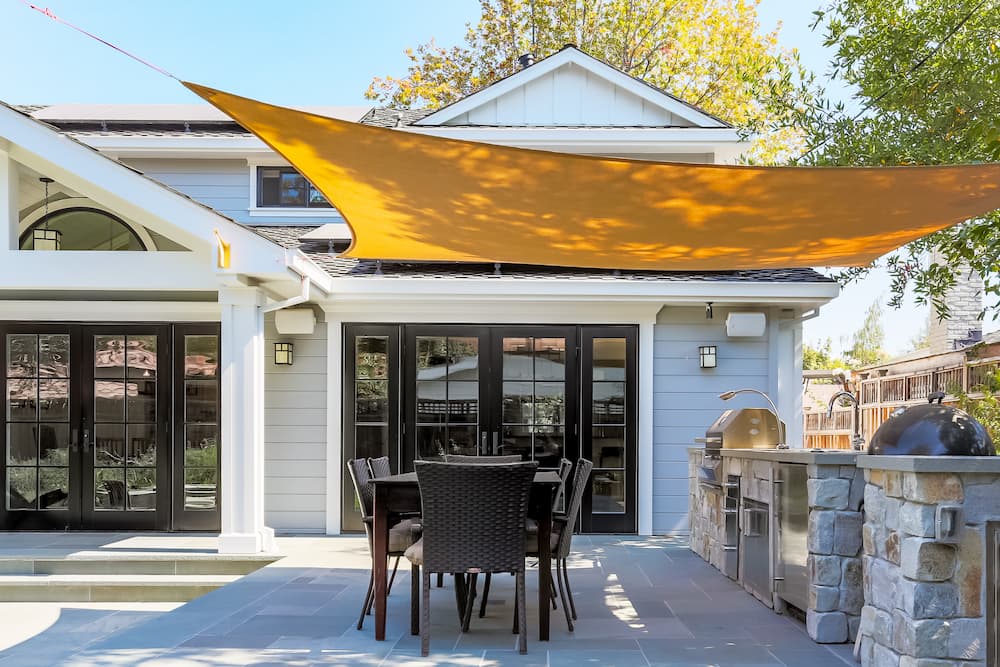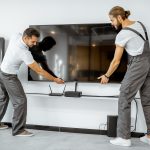As you read about weatherproofing your outdoor AV system, you’ll learn:
-
- How to use different weatherproofing solutions for audio equipment
- The advantages and disadvantages of each weatherproofing solution
- How to keep your entertainment space aesthetically pleasing with weatherproofed equipment
Installing an audio visual system is a great way to set up an outdoor entertainment area. Still, because most AV equipment is not built to be used outdoors, you will need to take some special measures to protect your AV system from the elements. You don’t want to disconnect and bring in your equipment every time it rains. By taking a few simple precautions, you can learn how to protect outdoor stereo equipment from the weather. Weatherproofing your outdoor AV equipment is the best way to extend its longevity, so you are happy with the investment you make in audio equipment. Here are four ways to weatherproof your AV equipment.
Build a Weatherproof Cabinet
Unless you purchase an expensive weatherproof television, you probably understand that an outdoor TV is a short-term investment. One way to get around this problem is to build a weatherproof cabinet to house the TV. Not only does a cabinet keep rain and hail from damaging your television, but it also keeps rodents from chewing on wires or building nests inside of the device. If you go this route, make sure you can close the cabinet securely and coat the exterior with a high-quality waterproof stain or paint. This will prevent water from leaking through and damaging the equipment inside the cabinet, and it will also enhance the aesthetic look of the cabinet.
The same concept works for audio equipment, and you can build a waterproof cabinet for outdoor stereo equipment easily. When you are ready to use the speakers, simply remove them from the cabinet and place them where you want them outside. When you’re done entertaining, leave the equipment hooked up to the right wires and place each speaker back into the cabinet. Ensure the cabinet is large enough to house all of your stereo equipment, and be careful to keep the wires from getting tangled up if you choose to go this route. It is important to get in the habit of putting away the speakers every time you are finished using them, so you know they are protected if it starts to rain unexpectedly. If you leave your speakers unprotected, they are more likely to get damaged.
Buy Special Speakers
Most audio equipment isn’t built to be used outdoors. Equipment that is suitable for outdoor use is often significantly expensive, and you may not be able to afford it. However, there are some speakers that can be used outdoors and are typically easy to repair if they get damaged. While you need to keep your primary method of playing music protected from the weather, you can leave special speakers shaped like rocks around the pool without worrying about bringing them in every day. Not only are they weather-resistant, but they also fit into your landscape, so you have surround sound without obvious speakers sitting around. Using speakers shaped like rocks makes for an aesthetically pleasing outdoor space with plenty of entertainment potential.
However, it is important to remember that these speakers are weather-resistant, not weatherproof. Leaving them out during inclement weather may lead to minor damage such as rusted grills, but these don’t usually affect the quality of your sound and are easy and inexpensive to replace. The most important thing to worry about if you choose to use these special speakers is that the wires need to be protected from the weather, which is easy to do with conduit coating. A little rainwater won’t affect weather-resistant speakers much, so it is best to go with this special equipment if you want an outdoor stereo system.
Keep Your Equipment Layout Structured
Having a central command station for all of your AV equipment is a good idea whether you use it indoors or outdoors. It makes it much easier to move your system from one location to another or pack up when you’re preparing to move to a new house. Having one command system also helps you to find problems easily and resolve them quickly because everything is in one convenient location. It also keeps your entertainment space neater because there is less clutter from audio equipment spread around the area.
Keeping your audio system structures isn’t difficult and could save you a lot of time if you ever need to move the equipment. You will have many wires running throughout your yard, and if you have them all hooked up to various audio equipment, it will be difficult to move your system because there are so many individual components. By making sure all of your audio equipment wires run to the audio transmitter, you can keep your system neat and structured. You can even take this a step further and include your indoor AV wiring. Bundle everything together to give yourself a central command center for all of your audio.
Bury Your Wires
Having a lot of wires running through your yard connecting various speakers to the audio transmitter can be dangerous. Not only do these wires serve as trip hazards, but if the copper wire gets wet during an unexpected rainstorm, it poses a risk for electrocution and could damage your entire system. You can protect your wires by investing in high-quality conduit coating. Secure the wires to the ground to reduce the risk of tripping and falling over them.
Even coated wires are unsightly and could take away from the desired look of your landscape. This is especially true if you have multiple speakers set up, which will require numerous wires running through your yard. If you want to hide the wires and protect them even further, you may want to consider burying them. Rather than using a conduit, you must coat the wire with a PVC jacket that is resistant to fungus and moisture, so it stays safe underground. You then dig a shallow trench a few inches deep and bury the wire. The buried wire is less likely to be damaged and will keep people from seeing visitors from seeing it stretched across your yard. However, it is essential to remember that burying a wire makes it more difficult to move. If you think there is any possibility that you may want to change the locations of your speakers, burying the wires may not be the right solution for weatherproofing your AV system. If you are searching for a permanent solution, this is the way to go.
If you invest a lot of money in an outdoor AV system, you want the equipment to last for many years, so you get the most for your money. You may not always know when it is going to rain, and you may not want to bring everything inside every time you have bad weather, so learning how to weatherproof your equipment is important. Using these simple tips can help protect your outdoor audio equipment from the elements, and you can shop at Performance Audio to find most of the weatherproofing equipment you need. Visit our shop or contact us today to ask about our inventory.
Featured Image: Krista Abel/Shutterstock





